Indoor container gardening is a fun hobby to pursue if you want a lively addition to your living spaces. You can mix and match colorful flowers, earthy green foliage, and the fragrant aromas of container plants that are suitable for full sun exposure.
The best container plants for the full sun include Angel’s Trumpet, Blanket Flower, Canna Lilies, Dianthus, Egyptian Star Flower, Gomphrena, Lavender, Million Bells, Petunias, Sedum, Verbena, Zinnia, and more, for a total of 20 great species!
To know more about these container plants, their physical attributes, hardiness, soil and water requirements, distinctive characteristics, and other related information, read further this article!
20 Best Container Plants for Full Sun
Agave
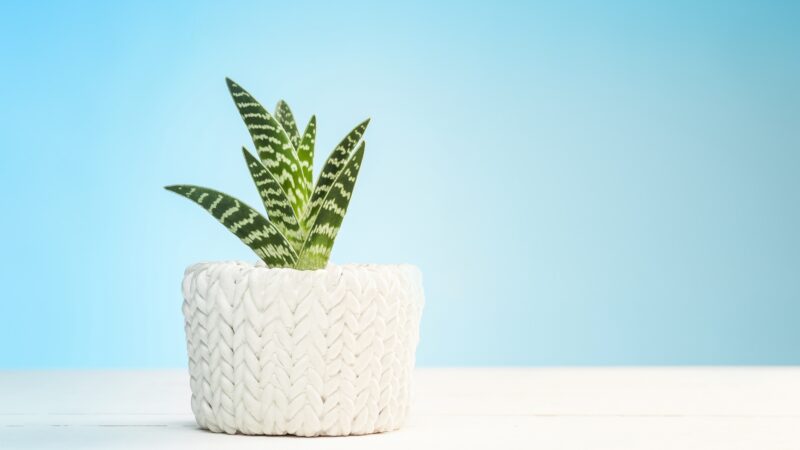
Agave is a genus composed of succulent perennials with extremely slow growth—it may even take up to 30 years. They usually will hold out for about 5 to 10 seasons before releasing a tall stalk of bright flowers.
As the entire plant gradually dies, offsets will naturally be produced from the plant. They are highly tolerant to even the hottest and driest summer seasons.
- Scientific Name: Agave L.
- Common Name: Century Plant
- Appearance: Generally has leathery leaves with spines along the edges, impressively tall stalks, and bright yellow flowers. Agaves can either be unbranched with blooms growing along their stalk or branched and develop flower clusters.
- Hardiness: USDA Zones 8 to 10
- Size: Up to 8 feet
- Soil & water requirements:
- An ideal soil is grave, sandy, or shallow rocky with good drainage. Depending on the species, soil can either be occasionally dry or very dry.
- Water once a week during warmer months but let the soil dry out a little before each watering.
Angel’s Trumpet
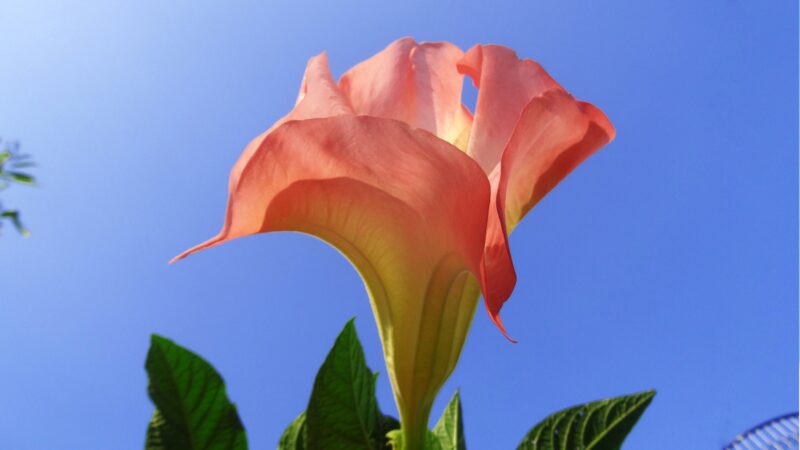
This genus is composed of exotic, tropical trees that are well-adapted to container culture as they can reach a manageable size through consistent root restriction and pruning.
Since these plants are native to South America, it thrives in warm and humid temperatures. They are also slightly tolerant to salt, light frost, and drought, as well as resistant to damage caused by deer.
- Scientific Name: Brugmansia
- Common Name: Moonflowers
- Appearance: Small trees that grow trumpet-shaped flowers, ovate-shaped and coarsely toothed leaves, and softly hairy on their stems when young. They typically have one trunk until they branch out.
- Hardiness: USDA Zones 7 to 12
- Size: Up to 30 feet
- Soil & water requirements:
- Prefers soil rich in organic matter, has good drainage and is consistently moist but not excessively wet.
- Water only when necessary (i.e., to keep the soil moist enough). Make sure that the soil won’t dry out too much.
Blanket Flower
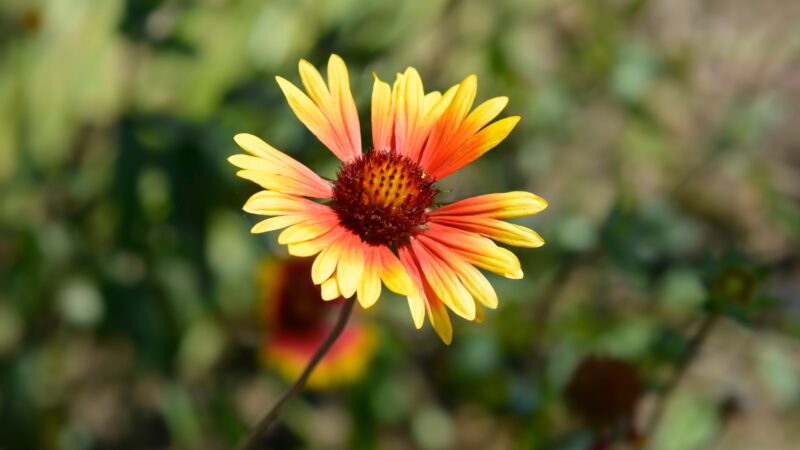
Its showy flowers look similar in appearance to blankets that are weaved by Native Americans, hence its common name. Its name could also refer to its “blanketing” growth habit.
Blanket Flowers produce prolific blooms, especially when exposed to full sunlight, and grow well as mass plantings in landscapes and containers.
- Scientific Name: Gaillardia pulchella
- Common Names: Firewheel, Indian Blanket
- Appearance: Has daisy-like flowers with long, flat, and three-toothed petals that are in bright shades of red, orange, and yellow. It also has large, alternate, grayish-green leaves that are strap-shaped and are generally soft and hairy-textured.
- Hardiness: USDA Zones 2 to 11
- Size: Up to 2 feet
- Soil & water requirements:
- Grows best in well-drained, occasionally dry sandy soil with a pH level of 6.0 to 8.0. They rarely survive through harsh winters if they are planted in heavier soil unless they are planted indoors.
- This plant can tolerate infrequent watering and will not survive when water-logged.
Calibrachoa
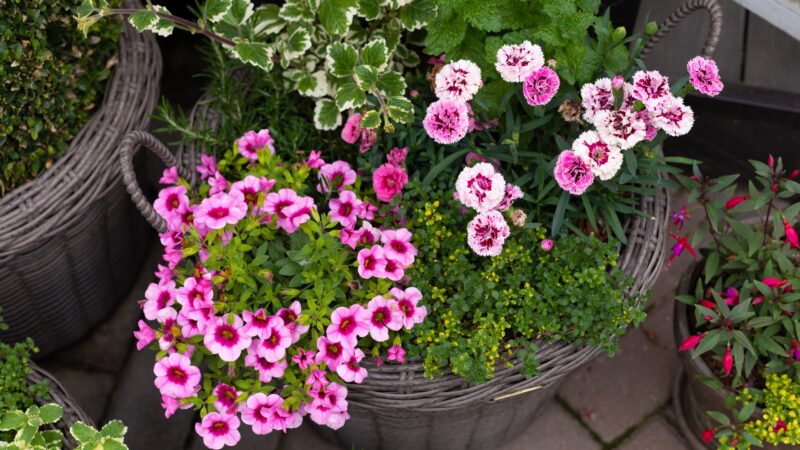
Calibrachoa is a genus of fairly new ornamentals in horticulture and gardening that is characterized by their resemblance to petunias due to the shape of their flowers.
These plants are native to South America and are suitable for planting in hanging baskets and containers under full sunlight exposure because of their trailing growth habit.
- Scientific Name: Calibrachoa
- Common Name: Trailing Petunia, Million Bells
- Appearance: Have bell-shaped flowers that can be red, yellow, blue, pink, white, magenta, violet, or bronze in color, as well as small, rounded leaves that are finely textured.
- Hardiness: USDA Zones 9 to 11
- Size: 3 to 9 inches
- Soil & water requirements:
- These plants are sensitive to the pH level of their soils, preferring acidic soils with a pH level of 5 to 6.5. They also require a well-drained soil that is rich in organic matter.
- Calibrachoas require daily watering. The soil must be moist but not excessively wet to prevent root rot. Their containers should have drainage holes for excess water.
Canna Lilies
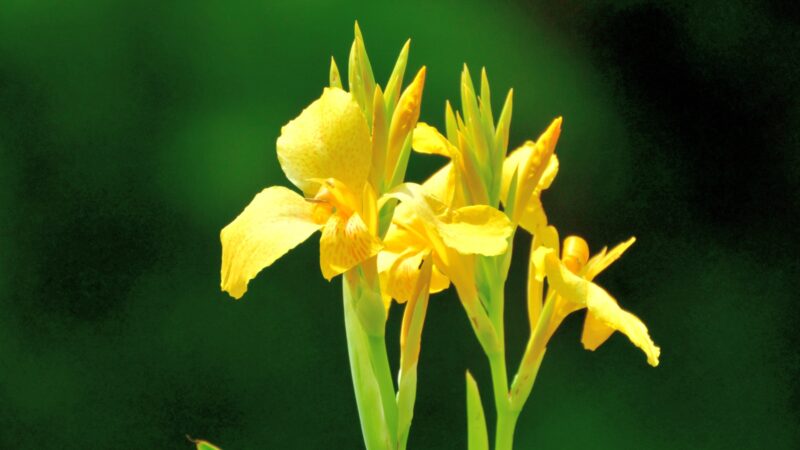
This heat-loving plant is best grown outdoors and then used as cut flowers indoors but may also be grown as houseplants, as long as they are placed in a sunny location.
Canna lilies were extremely popular since the Victorian period. It gives a tropical feel to gardens and public parks due to its interesting leaves and attractive flowers.
- Scientific Name: Canna X generalis
- Common Names: Canna, Canna Lily
- Appearance: Has large, arrowhead-shaped leaves that are either solid green or green with white or silver flecks. Its wide, trumpet-shaped flower may be yellow, peach, white, red, purple, pink, orange, or bicolored.
- Hardiness: USDA Zones 8 to 10
- Size: 3 to 8 feet
- Soil & water requirements:
- Prefers soil that is rich in organic matter and can hold an adequate amount of moisture. It is best planted in warm soil, specifically when the danger of frost has passed.
- This plant must be watered regularly if they are not planted in moist soil. The upper 6 to 8 inch-layer of the soil must remain moist.
Coneflowers
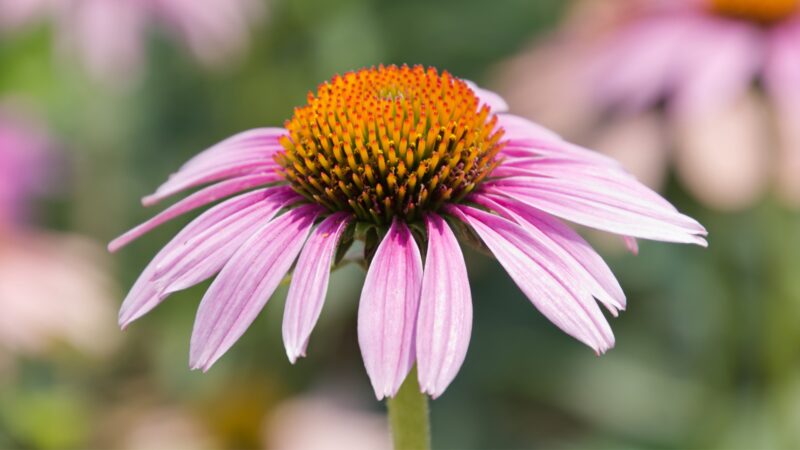
Native to the eastern and central United States, this plant is popularly planted in meadows, naive or pollinator gardens, or naturalized areas but can also be grown in uninsulated greenhouses.
This plant is also used for its medicinal properties when given in a high dosage for a short period of time. It is best placed in a location where it can receive full or partial sun.
- Scientific Name: Echinacea purpurea
- Common Name: Purple Coneflower
- Appearance: Relatively large wildflower with a spiny flower head and white or purple petal-like rays. Its leaves are lanceolate in shape with prominent tapered edges and are roughly textured. It also has an equally coarsely-textured, robust stalk.
- Hardiness: USDA Zones 3 to 9
- Size: 2 to 4 feet
- Soil & water requirements:
- It is generally tolerant to poor soil conditions, but it thrives best in enriched, well-drained soil, which can help this plant increase its life expectancy.
- Since the roots of this plant are relatively large, it requires sufficient watering, although they can survive a little dryness.
Dahlia
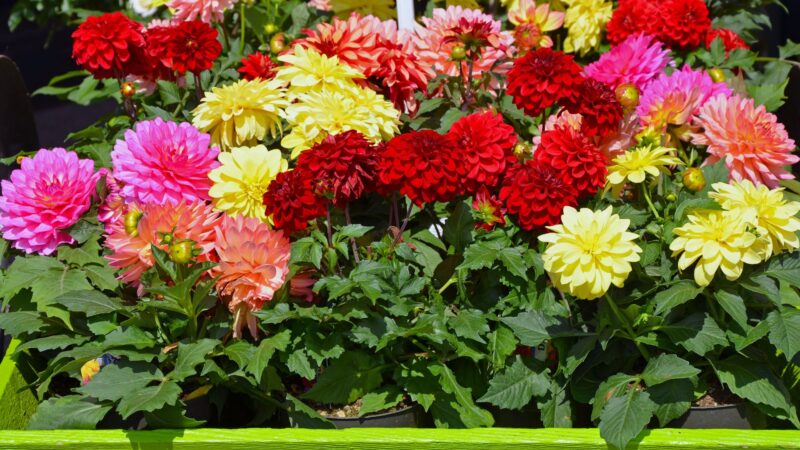
Dahlias are the stars of every garden during the late summer or early autumn season. Currently, there are 42 species available and are divided into ten groups, all requiring lots of sunlight exposure, although they are not tolerant to drought. Interestingly, all garden dahlias are considered hybrids, with seeds available commercially for the small-flowered varieties.
- Scientific Name: Dahlia spp.
- Common Name: Dahlia
- Appearance: Their showy, daisy-like flowers can be various shades of purple, yellow, red, orange, and pink. They also have simple, ovate, coarse-textured leaves.
- Hardiness: USDA Zones 8 to 10
- Size: 3 to 5 feet
- Soil & water requirements:
- Prefers fertile, well-drained soil that is consistently moist. These plants grow best when mulch is added to the soil and when less nitrogen is given. To establish a good root system, they must be planted in loose and crumbly soil with organic matter incorporated.
- Water thoroughly once a week if the plants are mulched. If not, water twice a week, especially during periods of extreme temperatures.
Dianthus
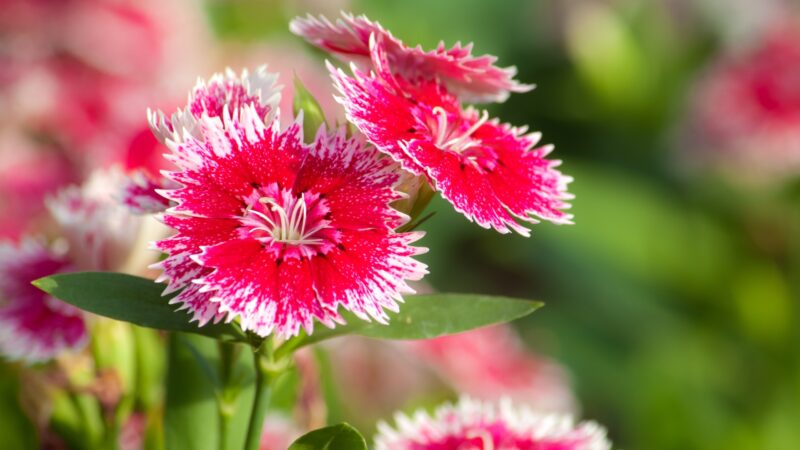
This genus has over 27,000 officially registered cultivars and can be grown as perennials, annuals, and biennials. Its common name, Pink, refers to its frilly or fringed flower edging which gives it a trimmed appearance. These plants have a distinctive sweet but spicy fragrance and prefer being planted in full sun but can still thrive under light shade.
- Scientific Name: Dianthus L.
- Common Name: Carnation, Pink
- Appearance: Bushy plants that have 5-parted flowers that are white, pink-lilac, or pink-purple in color, often having picotee margins. Depending on the species, they can be low-growing or tall and upright.
- Hardiness: USDA Zones 3 to 9
- Size: 10 to 20 inches
- Soil & water requirements:
- As long as the soil has good drainage and is occasionally dry, these plants are not particular to any soil type but grow best in neutral to slightly alkaline soil.
- Needs a normal amount of water. Overwatering can cause yellowing foliage and root rot.
Echeveria
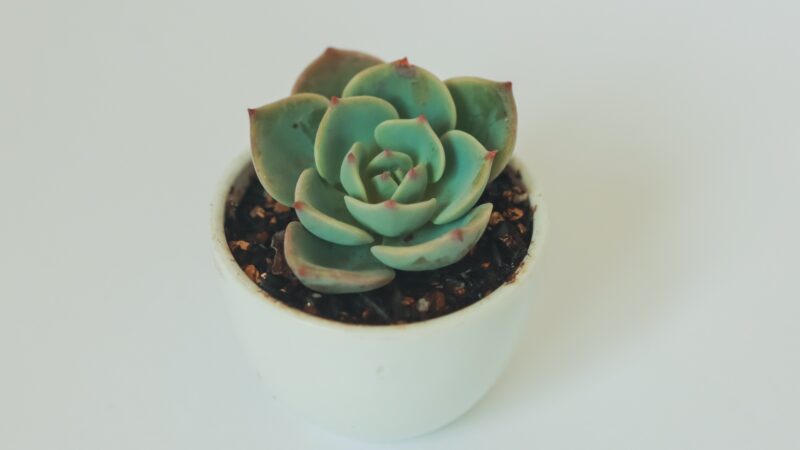
Echeveria is a group of beginner-friendly succulents usually placed in crevice or rock gardens as accent plants but also makes a perfect houseplant due to their small, compact size and ease of maintenance.
These plants do best in full sun and are tolerant to both heat and cold temperatures. They are also known for producing numerous offsets that can be rooted.
- Scientific Name: Echeveria
- Common Names: Mexican Rosettes, Variegated Wax Plant
- Appearance: Coarse-textured plants with thick, upright, and fleshy leaves with pointy margins, making them shaped like rosettes or spoons. These leaves are bluish, gray, or green in color. They also have white, pink, orange, or red bell-shaped flowers.
- Hardiness: USDA Zones 9 to 12
- Size: 1 to 2 feet
- Soil & water requirements:
- Grows best in well-drained sandy or loam soil.
- Water once weekly, or just make sure the soil doesn’t fully dry out. Never keep them too wet during winter.
Egyptian Star Flower
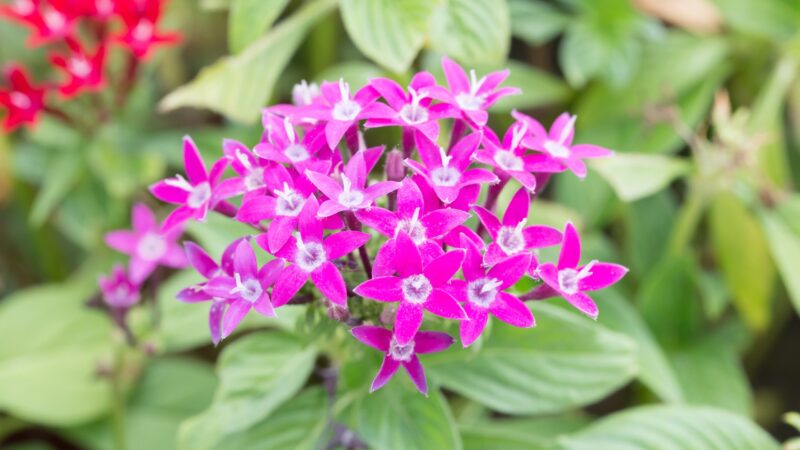
Best grown under full sun exposure, the Egyptian Star Flower can be planted as an indoor, border, or hedge plant. It is popular for its medium to high tolerance to drought and the fact that it is seldom damaged by deer.
This plant requires a minimum of 2 to 3 hours of full sun every day. The red-colored flower variety is especially popular among hummingbirds.
- Scientific Name: Pentas lanceolata
- Common Names: Egyptian Star Cluster, Pentas
- Appearance: Grows as either a tall perennial or upright shrub, this plant has star-shaped blossoms that vary in red, pink, lavender, and white shades. Its stems and ovate leaves are covered with fine hairs.
- Hardiness: USDA Zones 9 to 11
- Size: 2 to 3 feet
- Soil & water requirements:
- Prefers well-drained sand, loam, or clay with a pH level of not more than 6.0
- This plan prefers receiving regular moisture, but it can still thrive when water is occasionally given. Roots should not be dried out.
Euphorbia Diamond Frost
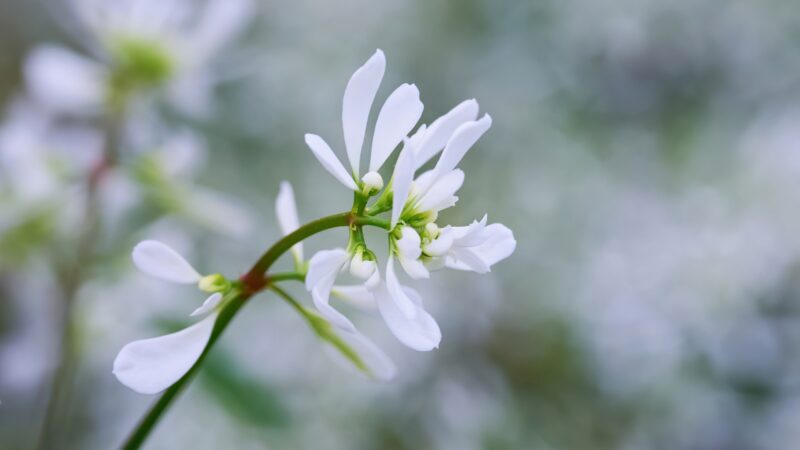
This plant is a cultivar of the graceful spurge, which grows as a tender perennial with a mounding growth habit. The Diamond Frost is particularly infertile, which means it does not produce any seeds and will never stop flowering, even in cooler temperatures. It is often used as a filler in floral arrangements, as well as planted in beds, borders, and containers.
- Scientific Name: Euphorbia hypericifolia ‘Inneuphe’
- Common Names: Graceful Sandmat, Graceful Spurge, Baby’s Breath Euphorbia
- Appearance: Thin, pale to bright green leaves with broad spacing are present on the tall stems. From spring till frost, the top of the canopy is covered in an abundance of tiny, snow-white “flowers.” In reality, the flowers are white petals that enclose the actual flowers.
- Hardiness: USDA Zones 10 to 12
- Size: 12 to 18 inches
- Soil & water requirements:
- This flowering ground plant can be grown in any kind of well-drained soil from full sun to partial shade.
- Water it roughly once a week, especially during growing seasons.
Gomphrena
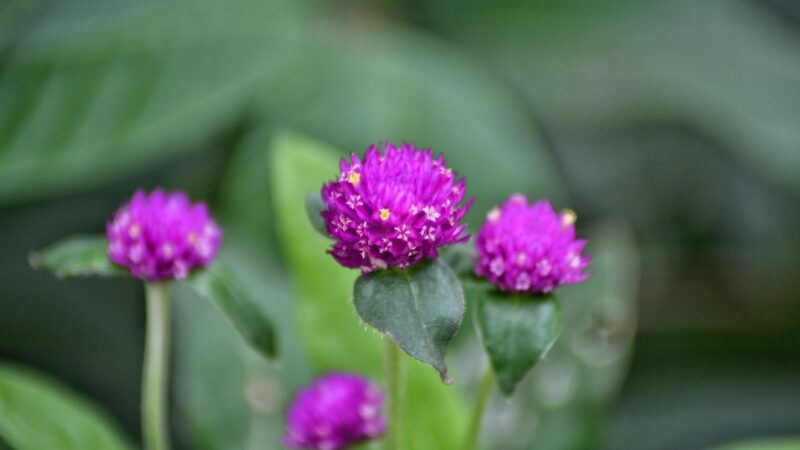
This plant is commonly utilized by horticulturists in a mass planting where they are spaced 12 to 18 inches apart. Gomphrena is also used as specimen plants placed in rock gardens or containers.
It blooms consistently throughout the summer season and does not usually require much maintenance. All it needs is full sun exposure as it is drought and heat tolerant.
- Scientific Name: Gomphrena globosa
- Common Name: Globe Amaranth
- Appearance: Grows clover-like flowers which are a bulk of inconspicuous, individual flowers that form a large group. Colors may be in shades of white, pink, and purple. It also has long, slender opposite leaves and hairy foliage.
- Hardiness: USDA Zones 9 to 11
- Size: 1 to 2 feet
- Soil & water requirements:
- Prefers moist but occasionally dry, well-drained soil. I can thrive in sandy, loamy, and clay soil that is acidic.
- Water when it experiences extremely dry weather, but be wary of overwatering.
Lantana
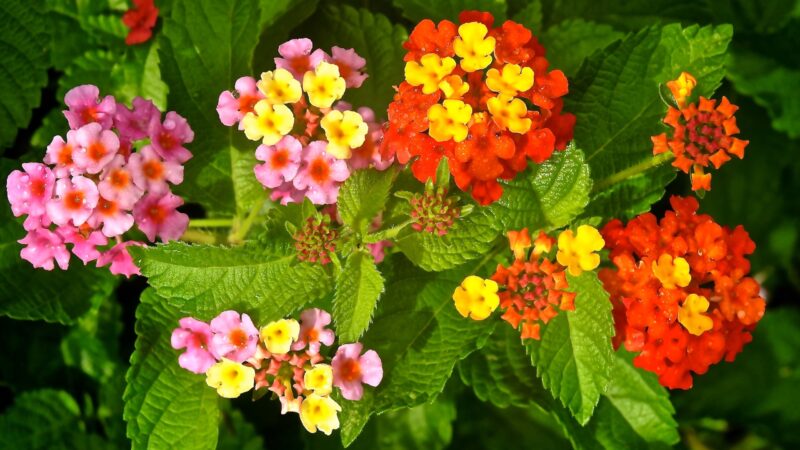
Often planted as an indoor plant, in flower gardens, in hanging baskets, or as a groundcover, Lantana is known for its incredible salt tolerance. Since its native habitat is in tropical climates, it does well in full sun, making it tolerant to heat and drought. Unfortunately, this plant is toxic to livestock and is highly invasive, so it’s best planted and maintained inside.
- Scientific Name: Lantana camara
- Common Names: Common Lantana, Shrub Verbena
- Appearance: Small evergreen shrub with woody stems and showy flowers that come in various colors of red, pink, yellow, orange, white, purple, or a mix.
- Hardiness: USDA Zones 7 to 11
- Size: 1 to 6 feet
- Soil & water requirements:
- This plant can tolerate all types of soil as long as they are slightly acidic, warm, and well-drained.
- Although it is resistant to heat and drought, this plant can produce more flowers when regularly watered, especially when it is newly planted.
Lavender
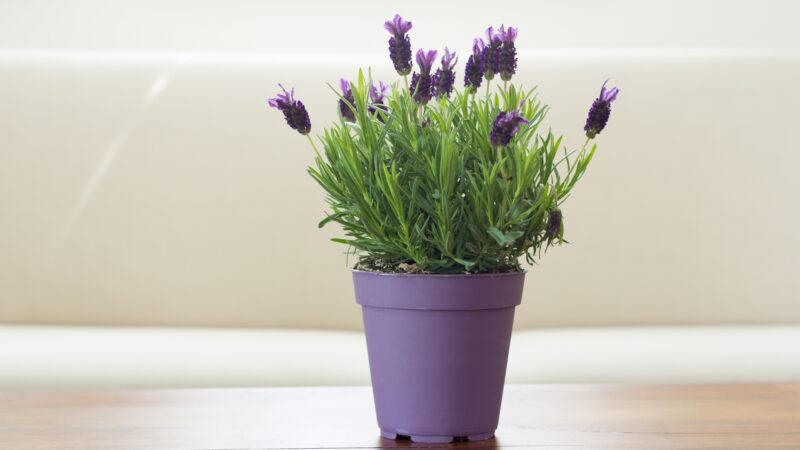
Lavender refers to a group of herbaceous shrubs, which are known for their essential oils and display value as ornamental plants. They are generally low-maintenance plants that thrive in warm locations where they can receive lots of sunlight but would also appreciate afternoon shade when grown in hot climates. Once established, they are extremely drought-resistant.
- Scientific Name: Lavandula L.
- Common Name: Lavender
- Appearance: Small shrubs that have spreading branches, grayish-green leaves, and long, flowering shoots. Its flowers are blue or lilac in color and grow either on spikes or shoots.
- Hardiness: USDA Zones 5 to 8
- Size: 1 to 3 feet tall
- Soil & water requirements:
- Sandy, well-drained soils with a Ph level of 5.8 to 8.3. When planted in lean soil, it will be able to produce a higher concentration of oils whereas when it is planted in alkaline soil, it will be characterized by a more aromatic fragrance.
- Lavenders do not require much water once they are established. However, when transplanting, they need to be regularly watered.
Million Bells
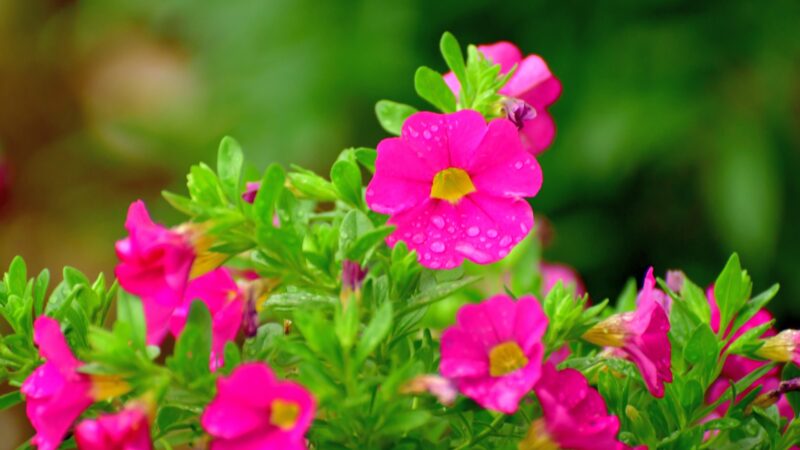
Commonly mistaken as petunias for their resemblance, Million Bells is increasing in popularity due to its interesting and attractive flowers as well as its compact foliage and trailing growth.
It is often hard to maintain as a bedding plant, which is why it’s typically planted in hanging baskets or containers. Million Bells require at least half a day of full sun exposure to remain in bloom.
- Scientific Name: Calibrachoa hybrid
- Common Names: Mini Petunia, Trailing Petunia
- Appearance: Grows clusters of small, half-inch, cup-shaped flowers ranging from pink to yellow to purple. Its leaves are elliptical and dark green in color with a slightly sticky stalk.
- Hardiness: USDA Zones 9 to 12
- Size: Up to 3 inches
- Soil & water requirements:
- Prefers soil that is moist, well-drained, and rich in organic matter. It also requires an initial application of slow-release fertilizer into the soil and a diluted liquid fertilizer in the succeeding weeks.
- Regular watering is necessary to sustain bloom, especially in the summer season. Be wary of overwatering as it may cause root rot.
Petunias
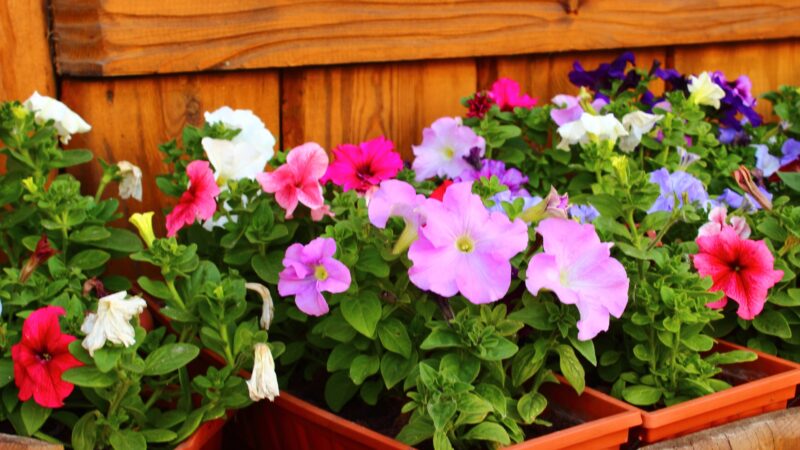
One of the most popular flowering annuals due to their lively and bright blooms, amazing fragrance, and ease of maintenance, Petunias are known to have hundreds of varieties that are categorized based on growth habit and size of flowers. All varieties require plenty of full sunlight, especially when grown in window boxes and other containers.
- Scientific Name: Petunia spp.
- Common Name: Petunia
- Appearance: Depending on the type, petunias can have large or small flowers which may be fringed, double, or ruffled in form. They can be found in every color on the rainbow and can be patterned with contrasting edges, veins, or stars.
- Hardiness: USDA Zones 9 to 11
- Size: 6 to 18 inches
- Soil & water requirements:
- Well-drained soil, preferably conditioned with compost, peat moss, manure, and other sources of organic matter. It grows best if a timed-release fertilizer is incorporated into the soil.
- Generally, petunias don’t require a lot of water. They only need to be watered once a week. However, wave petunias must be watered more frequently.
Portulaca
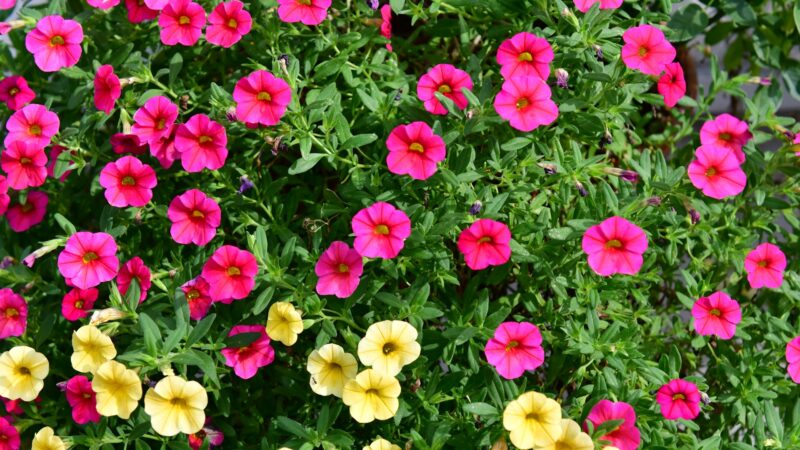
Native to South America, this low-growing flowering plant has blooms that need the sun to open as they become close on rainy and cloudy days, as well as from sunsets to dusk. They are usually used in crevice or rack gardens, as border plants, in pots, and on hanging planters. It is a self-seeding, non-invasive plant.
- Scientific Name: Portulaca grandiflora
- Common Name: Rose Moss
- Appearance: Has fleshy, succulent, and medium to dark green leaves with red-tinted stems and flowers that are cactus-like blooms in varying shades of pink, red, white, orange, and purple. Most of these flowers are ruffled and can be either single or double in form.
- Hardiness: USDA Zones 2 to 11
- Size: 3 to 8 inches
- Soil & water requirements:
- This plant is not particularly choosy when it comes to the soil type as long as it is well-drained and contains sufficient moisture.
- Although it is heat and drought-tolerant, the rose moss still needs to be abundantly watered, especially during the summer season
Sedum
Grown as ground covers, houseplants, landscapes, or interiorscapes, Sedum is a group of succulent, herbaceous plants consisting of over 300 species that generally need full to part sun.
They are easily grown indoors as long as they receive bright direct light. Its genus comes from the Latin word sedeo, which means to sit, referring to the growing habit of many species.
- Scientific Name: Sedum L.
- Common Names: Stonecrop, Orpine
- Appearance: Can be tall (has large flowers grouped in clusters and can be red, pink, yellow, or white in color) or low-growing (usually grown for their foliage and has smaller flowers).
- Hardiness: USDA Zones 3 to 11
- Size: 3 to 24 inches
- Soil & water requirements:
- These plants prefer well-drained and coarse soil, with cactus mixed used as a medium. However, it can tolerate rocky, poor, and dry soil.
- Due to their thick and waxy leaves, these plants generally do not need frequent watering. You still need to water them at least once a week until they become established, specifically if grown on porous soil.
Verbena
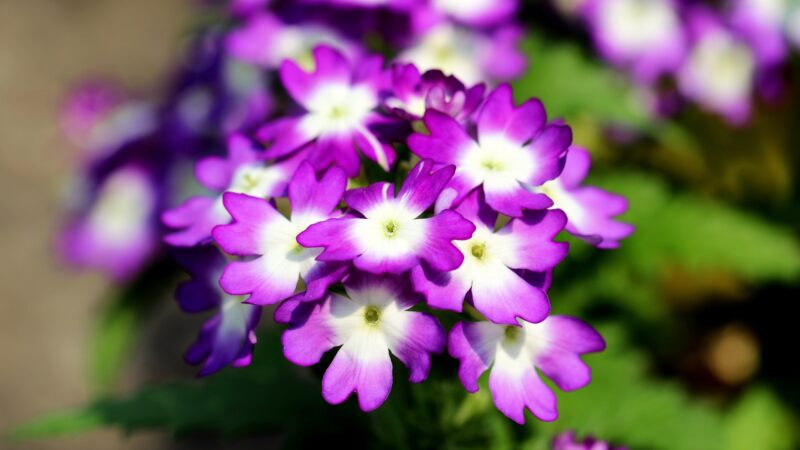
This genus contains around 150 species consisting of annual and perennial semi-woody or herbaceous flowering plants native to Asia and the Americas. Most commercially available verbenas are hybrids between species. They are grown as eye-catching plants in containers, hanging baskets, and garden beds, placed in sunny locations.
- Scientific Name: Verbena L.
- Common Names: Vervain, Verveine
- Appearance: Characterized by having small, slightly tubular, compound flowers and finely-toothed, lanceolate leaves. They can grow tall and upright as well as trailing and mounded.
- Hardiness: USDA Zones 8 to 11
- Size: 6 to 18 inches
- Soil & water requirements:
- The soil must be kept consistently moist but not excessively wet, or else the plant will lose its blooms. When using poor, sandy soil, frequent fertilization is necessary.
- Water them thoroughly and frequently during their blooming period and accompany them with fertilizer if the blooms slow during summer. The plants should not be allowed to dry out.
Zinnia
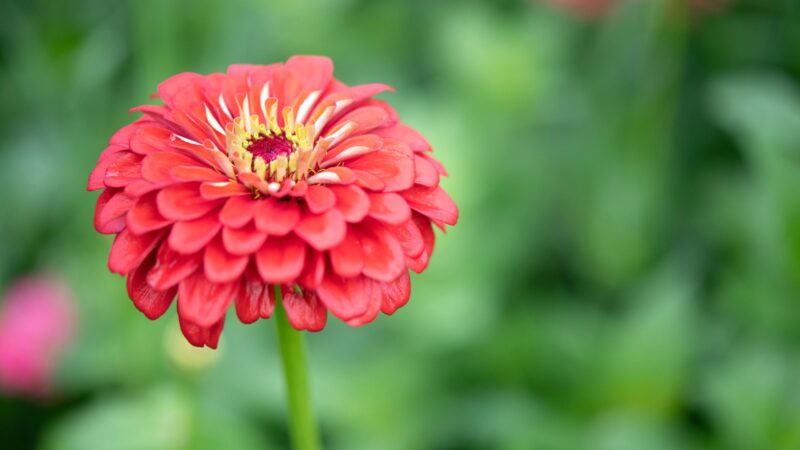
Zinnia is an erect, prolific annual bloomer that is easy to grow and extremely attractive to pollinators such as bees and butterflies. They thrive best in garden beds, landscape locations, and mass plantings but can also be grown in containers and kept indoors. Zinnias require at least 8 hours of full sun exposure daily.
- Scientific Name: Zinnia elegans
- Common Names: Common Zinnia, Elegant Zinnia
- Appearance: Grows as bushy mounds with leaves that are oval to elliptical in shape and showy flowers that can be single, semi-double, and double in form and range from red, orange, yellow, green, pink, lavender, white, to rose.
- Hardiness: USDA Zones 3 to 10
- Size: 6 to 18 inches
- Soil & water requirements:
- The soil must have a pH level of 5.5 to 7.5 and should be well-drained. To improve drainage, sand or compost may be incorporated into heavy, compact soil.
- Regular watering should be observed when the upper 1 to 2 inches layer of the soil is dry. The soil should slightly dry out between waterings.
List of Sources
Purple Coneflower – http://www.bio.brandeis.edu
Growing Petunias – https://extension.umn.edu/flowers/growing-petunias
Agave – https://rwwgreenhouse.voices.wooster.edu/agave/
Calibrachoa – https://extension.umn.edu/flowers/calibrachoa
Dahlia Spp. Dahlia – https://edis.ifas.ufl.edu/publication/FP169